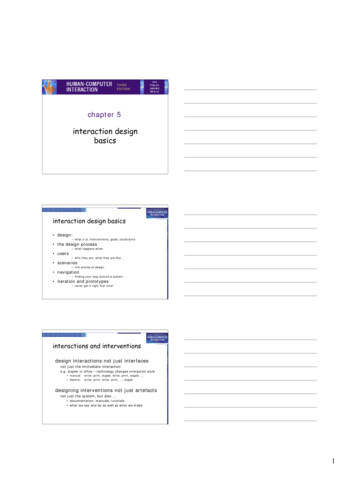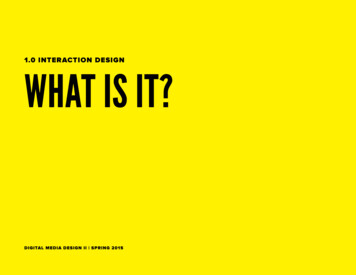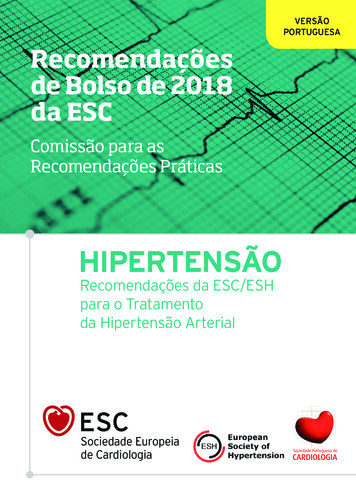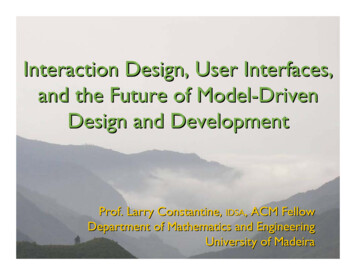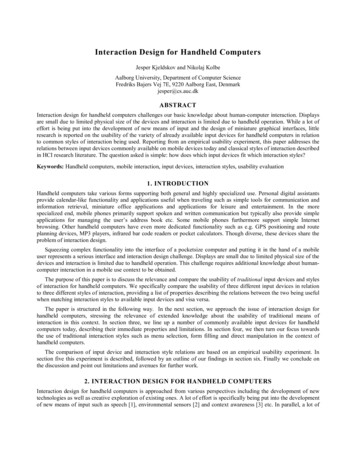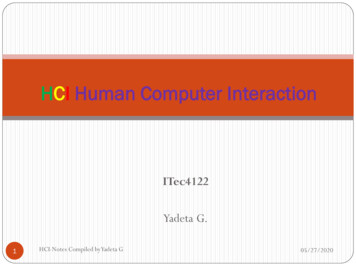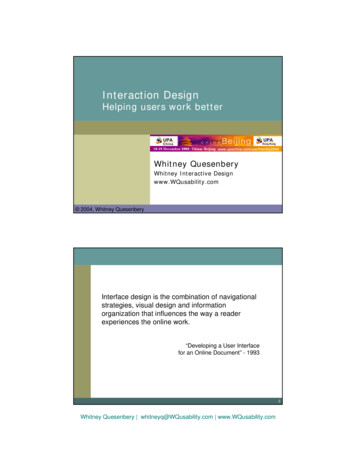
Transcription
Interaction designD. MurrayCO33482010Undergraduate study inComputing and related programmesThis is an extract from a subject guide for an undergraduate course offered as part of theUniversity of London International Programmes in Computing. Materials for these programmesare developed by academics at Goldsmiths.For more information, see: www.londoninternational.ac.uk
This guide was prepared for the University of London by:Dr Dianne Murray, HCI Consultant, London, UK.This is one of a series of subject guides published by the University. We regret that due to pressure of work the author isunable to enter into any correspondence relating to, or arising from, the guide. If you have any comments on this subjectguide, favourable or unfavourable, please use the form at the back of this guide.AcknowledgementsWe are grateful to the following for permission to reproduce material:Figure 2.1: User-Centred Design, Penn State UniversityFigure 2.2: HCI Design Process, Penn State UniversityFigure 2.3: Conceptual Models, www.interactiondesignblog.comFigure 2.6: Star Model, reproduced by permission of the authorsFigure 3.1: Scenario-Based Development Framework, reproduced bypermission of the authorsFigure 3.2: reproduced by permission of the author.The University has made every effort to trace authors and copyright holders.We apologise for any omissions in the above list and will welcome additions or amendments to it for inclusion in any reprintedition.University of London International ProgrammesPublications Office32 Russell SquareLondon WC1B 5DNUnited Kingdomwww.londoninternational.ac.ukPublished by: University of London University of London 2010The University of London asserts copyright over all material in this subject guide except where otherwise indicated. All rightsreserved. No part of this work may be reproduced in any form, or by any means, without permission in writing from thepublisher. We make every effort to respect copyright. If you think we have inadvertently used your copyright material, pleaselet us know.
ContentsContentsPreface. 1About this course unit. 1Assessment. 2Examination guidance. 2Coursework guidance. 3Course aims. 4Learning objectives. 5Learning outcomes. 5The Study Guide. 5How to use the Study Guide. 5Structure of the guide. 6Suggested study time. 7Recommended texts. 7Supporting resources. 9Recommended textbook. 9Alternative textbook 1 . 10Alternative textbook 2 . 11Sources of further information. 12Web-based and online resources. 15Case studies. 17Acronyms. 17Chapter 1: Introduction to HCI and Interaction Design. 19Learning outcomes. 19Essential reading. 19Introduction. 191.1 Definitions. 201.2 Why study user interaction?. 201.3 Early HCI. 211.4 Why it changed. 221.5 HCI in the 1970s and 1980s. 231.6 The situation today. 24Summary. 24A reminder of your learning outcomes. 24Exercises. 25Sample examination question. 25Further reading. 25Chapter 2: Interaction and design approaches. 27Learning outcomes. 27Essential reading. 27Introduction. 282.1 What is design?. 282.2 Some principles of design. 312.3 Problem space and design space. 352.4 Design methodologies and approaches. 372.5 The design activity . . 44iCIS 348 Interaction Design 2010 BOOK.indb 124/01/2011 12:20:54
348 Interaction design2.6 Idea generation. 48Summary. 49A reminder of your learning outcomes. 49Exercises. 49Sample examination question. 50Further reading. 50Chapter 3: Techniques for Interaction Design requirements. 51Learning outcomes. 51Essential reading. 51Introduction. 523.1 Task Analysis. 523.2 Data collection for gathering user and task requirements. 533.3 Asking users. 543.4 Eliciting qualitative data. 563.5 Analysing qualitative data. 613.6 User narratives. 633.7 Prototyping. 653.8 Task Analysis and requirements gathering in use. 66Summary. 67A reminder of your learning outcomes. 67Exercises. 67Sample examination question. 68Further reading. 68Chapter 4: Usability. 69Learning outcomes. 69Essential reading. 69Introduction. 694.1 Usability. 704.2 International standards. 734.3 The Usability Profession. 76Summary. 77A reminder of your learning outcomes. 77Exercises. 77Sample examination question. 77Further reading. 77Chapter 5: Evaluation and usability assessment techniques. 79Learning outcomes. 79Essential reading. 79Introduction. 795.1 Informal techniques. 805.2 Formal techniques. 855.3 Choosing a technique. 905.4 Professional input. 91Summary. 91A reminder of your learning outcomes. 92Exercises. 92Sample examination question. 92Further reading. 92iiCIS 348 Interaction Design 2010 BOOK.indb 224/01/2011 12:20:54
ContentsChapter 6: Designing for different users. 95Learning outcomes. 95Essential reading. 95Introduction. 956.1 Culture and Universal Usability. 966.2 Inclusive Interaction. 996.3 Accessibility. 102Summary. 104A reminder of your learning outcomes. 105Exercises. 105Sample examination question. 105Further reading. 106Case study. 107Chapter 7: Design case studies. 109Learning outcomes. 109Essential reading. 109Introduction. 109A selection of case studies. 1107.1 hcibook. 1107.2 Interaction Design (ID2). 1117.3 HFRG. 1127.4 Equator. 1127.5 UPA. 1137.6 Other case studies. 113Summary. 113A reminder of your learning outcomes. 113Exercises. 114Further reading. 114Chapter 8: Interaction Design and new technologies. 115Learning outcomes. 115Essential reading. 115Introduction. 1158.1 Tangible Interaction. 1168.2 Affective Interaction. 1178.3 Virtual Environments. 119Summary. 120A reminder of your learning outcomes. 120Exercises. 121Sample examination question. 121Further reading. 121Chapter 9: Real world interactions. 123Learning outcomes. 123Essential reading. 123Introduction. 1239.1 Ubiquitous Computing. 1249.2 Seductive Interfaces and Flow. 1249.3 Ambient Intelligence. 125iiiCIS 348 Interaction Design 2010 BOOK.indb 324/01/2011 12:20:54
348 Interaction design9.4 The Internet of Things. 1269.5 Impacts. 1269.6 Relevance to ID and HCI. 128Summary. 128A reminder of your learning outcomes. 129Exercises. 129Sample examination question. 129Further reading. 129Appendix 1: Sample examination paper. 131Appendix 2: Bibliography. 133HCI textbooks. 133Reference texts. 133HCI and ID books. 134Edited collections of readings in HCI and ID. 136Appendix 3: Chapter summaries. 139ivCIS 348 Interaction Design 2010 BOOK.indb 424/01/2011 12:20:54
PrefaceAbout this course unit » Course aims, learning objectives and outcomes »The Study Guide » Recommended texts and supporting resources »Sources of further information » AcronymsAbout this course unitCIS 348, Interaction design, is a half unit Level 3 option for the BSc/Diploma in Computing and Information Systems (CIS) and the BSc/Diploma in Creative Computing. The course has no specific or formalpre-requisite course unit or technical requirements. However, studentsshould have a good general awareness and experience of a range of currentcomputer-based systems, ranging from stand-alone and mobile applicationsto internet-based and commercial ones. To obtain the most benefit fromthis course unit, students should be interested in the human aspects ofusing new technologies and novel interaction media. The course unit doesnot cover applications programming, software development, technologicalsolutions or analysis of such systems. An interest in and willingnessto learn about aspects of user psychology, most especially some basicconcepts in experimental and cognitive psychology, will be necessary.Although this may appear challenging for those with no prior experience inthis area, the core Essential and Further reading should suffice.CIS 348 is an updated replacement for CIS 315, Human ComputerInteraction, and shares some basic material with it. Prior material onsample examination questions and past Examiner’s reports will stillbe broadly applicable. The course unit has been brought up-to-date, itsemphasis refocused more on the design of human-computer and humantechnology interactions, based on the needs and requirements of the usersof such technologies, and assessing how such interactive applications areused in real-life. This course unit introduces the study of Human ComputerInteraction (HCI) together with the newer area of Interaction Design (ID).Knowledge of interface design and user requirements is critical to manyaspects of software development and applied computing. Increasingly,resources are devoted to the design and optimal functioning of interfaces toan increasing range of interactive technologies. Standards and accessibilitylegislation and guidance are now a crucial element in commercial interfacedesign, which means that new applications are being created with anemphasis on good design and user participation. The world that HCIinvestigates and researches is developing into a mobile, ubiquitous andambient one. The ‘computer’ has been extended and, in many cases, replacedby numerous mobile interactive devices. Users are no longer homogeneousbut increasingly form new and distinct user groupings. The concept of ausable interface has been revolutionised by devices such as the iPod and1CIS 348 Interaction Design 2010 BOOK.indb 124/01/2011 12:20:54
348 Interaction designiPhone, and people increasingly recognise and expect to be able to useelectronic devices easily and without difficulty. The global expansion oftechnology means that localisation and internationalisation issues assumegreater importance. The expansion of commercial web-based applications ine-commerce and e-government will undoubtedly continue apace. New typesof interaction based on gesture, touch, motion and speech are increasinglycommon and can be seen in current commercial products. Social networking,community computing and immersive technologies have become afundamental part of the lives of many, and home-based applications ofnew technologies abound. Games and the associated new markets inentertainment computing, learning technologies and virtual applicationscontinue to push the boundaries of creative computing. An increasinglyelderly population in many parts of the world has led to a new emphasis onassistive technologies and for health-related technology-based applications.Given this snapshot of current impacts, students need to be able to engagewith future technologies and to fully appreciate and understand thedesign principles which create effective interactive applications, and to bewell-prepared to apply them in their future jobs and careers as computerprofessionals and practitioners. This introductory course unit is thus essentialfor anyone who will be involved in the analysis, design, development orevaluation of interactive applications of any kind. The aim is to go beyondmere ‘guidelines for good design’ and to enable students to develop anunderstanding of the principles of interaction, to identify problems with aninterface, to understand how such interactions may be improved and to gainthe knowledge necessary to be able to design better interfaces. This StudyGuide will introduce and discuss the topics and technologies describedin the previous paragraph and will enable students to gain an up-to-dateunderstanding of what it means to be an Interaction Designer.AssessmentImportant: The information and advice given in the section below are basedon the examination structure used at the time this guide was written. Pleasenote that subject guides may be used for several years. Because of this westrongly advise you to always check the current Regulations for relevantinformation about the examination. You should also carefully check therubric/instructions on the paper you actually sit and follow those instructions.The course unit is assessed by an examination of three (out of a choice offive) questions. The examination questions are essay-based but do havea strong element of applied design and interpretation of the techniquesstudied during the course unit. Guidance is given in the next section. Thereare also coursework assignments. The essay- or report-type assignmentsare similar to those that have recently been set for the CIS 315 courseunit and will change in topic every year. They should allow studentsto become better informed about selected specific aspects of HumanComputer Interaction and Interaction Design and to enable exploration ofthe extensive online information available for this subject. Again, specificdetails and guidance can be found later in the Study Guide.Examination guidanceFor appropriate examination preparation, please take note of the followingpoints:2CIS 348 Interaction Design 2010 BOOK.indb 224/01/2011 12:20:54
Preface Take a few minutes to make a plan of each question and to gather yourthoughts instead of immediately starting to write. Ensure that you fully understand the topic area of the question. Ensure that you can answer every part and section of the question.Being able to answer only part of the question will not help you achievea good overall mark. Do not spend unnecessary time restating the question, either in yourown words or in repeating the question text. This is not required andwill use up valuable time. Do not spend examination time answering one question at the expenseof others: it is generally better to answer three questions in full than onein great detail and two very briefly. Do not repeat details from one section in another section: it is unlikelythat this is what the Examiner intended and the focus of your answer ineach section should be quite distinct. Ensure that the level and detail of the answer you give corresponds tothe marks allocated. Do not spend too much time and effort on a partof the question that is worth only a few marks. Similarly, do not merelywrite cryptic notes or single points for a part of the question that isworth a large number of marks. Try to achieve the balance reflected inthe marks indicated. Read the question carefully and answer in the way that is requested:wording such as ‘describe’, ‘compare and contrast’, ‘itemise’, ‘illustrate’,‘explain with diagrams’ tells you what sort of answer is expected andwhat sort of detail you should go into. Make sure you understand whattype of answer is required and do provide diagrams or examples whererequested as this is part of the marking scheme for the question. Do not spend time providing unnecessary diagrams. If diagrams arerequested, they should be clearly labelled and described. Providing asan answer an unlabelled diagram from memory without a descriptionwill not attract good marks. Do try to use tables and lists where appropriate – for example, in aquestion which asks you to contrast two approaches or itemise thedifferences between two aspects of a topic. Organise your time to allow sufficient time to read over what you havewritten and to make any necessary corrections.Coursework guidanceCoursework will generally be in an essay format. A detailed statementof what is required will be produced, with the marking scheme clearlyindicated and suitable references given. The following guidance will helpyou to produce high quality coursework: You will be required to provide an electronic copy for plagiarismchecking purposes. Any submission without any electronic copy willnot be marked. Very short submissions are also unacceptable. You should write in a report or essay format – not in note or bulletpoint form – with a defined structure as detailed in the courseworkinstructions. You do not need to restate the question asked or provide a3CIS 348 Interaction Design 2010 BOOK.indb 324/01/2011 12:20:55
348 Interaction designtable of contents, an index or a cover sheet, or any extra information orappendices, and you should attempt to minimise the use of paper. The structure, clarity and organisation of your work will be assessedand some marks awarded for it. Your submission must be wellpresented in a coherent and logical fashion. It should be spell- andgrammar-checked and you should structure it so that you have both aclear introduction and a conclusion. A concluding section is a requiredpart of your coursework submission. You should include relevant diagrams, drawings, illustrations or imagessuch as graphics and screenshots as coursework is likely to involve adesign scenario and production of paper-based prototypes. These willhave an impact on the readability and presen
Interaction design D. Murray CO3348 2010 Undergraduate study in Computing and related programmes This is an extract from a subject guide for an undergraduate course offered as part of the University of London International Programmes in Computing. Materials for these programmes are developed by academics at Goldsmiths.File Size: 1MBPage Count: 63


